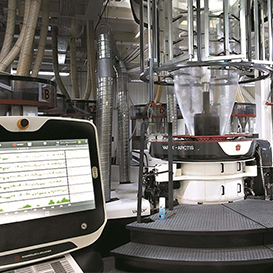REVaMP²
REVaMP² enables profitable engineering of mass-customised products and services

- Project
start
November 2016 - Project
end
December 2019 - Project
leader
Andrey Sadovykh
Softeam, France - More
information
https://revamp2-project.eu
More and more B2B and B2C products and services are obtaining leading market positions by becoming more software-intensive. You can think, for example, of cars and lawn mowers, which have completely transformed into cyber-physical systems that fulfil many more functions than they originally did. A big advantage of software-intensive systems and services is that they hold the key to mass customisation (which is almost a must nowadays) to create customer satisfaction, loyalty and trust. Software systems create and adapt to innovative market disruptions and customer desires far quicker and at lower costs than their less software-based competitors. However, they also raise new engineering challenges. In particular, they require more agile, round-trip engineering processes (that better leverage legacy assets) and more systematic and automated variability management. The first supplier to master this in a given market will hold a decisive competitive advantage.
The ITEA project REVaMP², gathering 30 partners from Belgium, France, Germany, Spain and Sweden, has created the first comprehensive round-trip engineering automation platform and process to support extractive, bottom-up Product Line Approach adoption and maximise the reuse of legacy assets. An important innovation is a methodology to support Product Line Engineering, integrating the:
- extraction of a software-intensive product line and variability model from the legacy assets of implicitly related software system sets.
- multi-view visualisation of legacy assets, extracted variability models and product line assets.
- verification that a software-intensive product line satisfies a set of hard constraints such as safety restrictions.
- refactoring of a software-intensive product line to optimise soft constraints on the refactored assets and to co-evolve related assets such as software algorithms and the hardware architectures on which they run.
REVaMP² is therefore able to identify core functionalities and key variation points automatically. In doing so, it reinforces the shift from one-off product sale transactions towards service subscription packages.
Reducing time to market and manual effort
Promising technology results have already been seen by the consortium, including a reduction of Softeam’s time to market for custom bundles from six weeks to three. Softeam has continued to work in product-line engineering research and established a collaboration with Volvo Construction Equipment for further joint work in this domain. This research is being continued in two research projects, MegaM@ Rt and AIDOaRt. In addition, the sales of Softeam’s Modelio product have had a steady annual growth of 35% for the last two years. The innovation resulting from the REVaMP² project has contributed to this success.
Project partner ABB uses parts of the REVaMP² tooling to ensure the source code quality of the frequency converter firmware. The tooling supports the development department in the continuous improvement and continuous development pipeline with automated checks regarding the software architecture to ensure that the customer features are correctly integrated in the firmware. Additionally, it reduces the manual effort in the development and maintenance of the firmware variants through automatic build script generation for the different firmware variants of ABB’s frequency converters (ABB Drives).
New customers
As new types of software-intensive product line engineering spread across key economic sectors like manufacturing, transportation and healthcare, so too will the demand for toolchains like REVaMP². This has already resulted in 24 new or enhanced products, services and systems.
Siemens, for instance, has been able to fast-track the technology readiness level of product-line engineering support. Key results of REVaMP² are now integrated within the new Simcenter Studio product, released in 2021 as a stand-alone tool for early product design. Among these technology bricks are new solutions to compare product architectures and to integrate different modelling languages (including SysML v2 and the proprietary generative engineering language ACEL). The customer portfolio of the Simcenter product is rapidly increasing in the automotive and aerospace domain.
REVaMP² will herald a new era of automatic development for variable products.
As part of REVaMP², MES has extended its static analysis tool MES M-XRAY with the detection and visualisation of architecture-relevant Simulink model components. New architectural analysis functionality allows the user to determine signal dependencies between selected model components. These enhancements have attracted customers from the automotive sector, including departments at an OEM and Tier 1 that were new to MES, and additional licences were sold.
The Reuse Company has managed to integrate the whole REVaMP² project inside their commercial tool, SES ENGINEERING Studio: a software tool designed to orchestrate the development of all kinds of systems (hardware, hybrid, software). It allows interoperability between an unlimited number of existing systems engineering tools (requirements management, MBSE tools, simulation tools, risk management, RAMS management, MS Office, etc.). Thanks to the newly added REVaMP² component, they have sold licences of this tool to a European multinational aerospace company that was not included in the project consortium.
Together with Sirris, Macq worked on the ontology of assets and changed its development cycle into an ideation funnel process - a mechanism that allows the screening of a continuous stream of innovative ideas and prototypes for viability. Supported by new DevOps and testing teams, this resulted in a new series of smart mobility cameras connected to a now more modular smart mobility manager called M3. These cameras are used for speed control on routes and LEZ (Low Emision Zones). They increase road safety and improve particulate emissions in cities. Macq now has more product variants, which are easier to install. Currently, about 700 cameras of the new series have been sold to an increasing number of international customers.
In terms of human capital, 14 new positions were created across the consortium.
As REVaMP²’s results are domain-independent, dissemination will help the toolchain to spread to virtually any economic sector. In turn, this will herald a new era of automatic development for variable products, allowing organisations to affordably cater to niche markets and minorities in ways that were previously unimaginable.

Other chapters
Use the arrows to view more chapters

Editorial
By Jean-François Lavignon

Country Focus: Spain
Competitiveness through collaboration

ACCURO
Coming back for more – the pull of ITEA

ITEA Success story: REVaMP²
REVaMP² enables profitable engineering of mass-customised products and services

Community talk with Jos van Sas
The delights of being on the circle’s edge

By and for end-users
Vizelpas pushes predictive maintenance to the next level in the PIANiSM project

ITEA Success story: SPEAR
A new approach to energy optimisation for industry

Glancing back at the ITEA PO Days 2022 & Family reunion
Three days of familiar onsite inspiration and innovation

SME in the spotlight: KE-Works
Where digitalisation and collaboration meet

